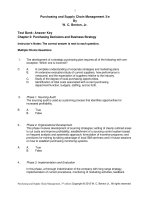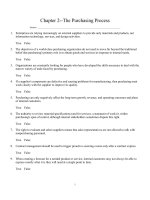Lecture Purchasing and supply chain management (3rd/e): Chapter 11 - W. C. Benton
Bạn đang xem bản rút gọn của tài liệu. Xem và tải ngay bản đầy đủ của tài liệu tại đây (626.08 KB, 14 trang )
Chapter 11:
Supply Partnerships and
Supply Chain Power
Purchasing and Supply Chain Management
3rd edition
Purchasing and Supply Chain Management, 3rd edition, Copyright © 2013, W. C. Benton Jr., All rights reserved.
Purchasing and Supply Chain Management, 3rd edition, Copyright 2013, All
1
The WinWin Partnership Dyad
•
•
Buyer and supplier share goals and risks through:
•
Joint planning and control
•
A supply chain with increased information flow and enhanced
loyalty
The result for both firms:
•
Decreased uncertainty
•
Greater control of costs
•
Cycle times, inventory
•
Quality, customer satisfaction
2
Purchasing and Supply Chain Management, 3rd edition, Copyright © 2013, W. C. Benton Jr., All rights reserved.
Partnership
•
Definition:
A tailored business relationship for achieving a competitive
advantage based on:
•
•
•
Mutual trust
•
Openness
•
Shared risk
•
Shared reward
Strategic partnerships receive benefits of joint ventures
and vertical integration without the ownership
commitment
3
Purchasing and Supply Chain Management, 3rd edition, Copyright © 2013, W. C. Benton Jr., All rights reserved.
Benefits and Risks of Supplier Partnerships
•
•
Benefits:
•
Higher quality, and transaction costs
•
Increased market stability
•
Setup time reduction, improved processoriented layout
•
Increased communication and goal congruence
Risks:
•
Partner may not meet expectations
•
Loss of partnership control
•
Complacency
4
Purchasing and Supply Chain Management, 3rd edition, Copyright © 2013, W. C. Benton Jr., All rights reserved.
Large vs. Small Suppler Bases
•
Benefits of a large competitive supplier base:
•
Higher manufacturer bargaining power
•
•
•
Lower costs, higher quality, reasonable delivery times, and special
exigencies
Shelters against supply interruptions
Benefits of a smaller supplier base:
•
Less adversarial attitudes
•
Lower switching costs
•
Decreased shipping errors
Quantity and relationshipbased discounts
5
Purchasing and Supply Chain Management, 3rd edition, Copyright © 2013, W. C. Benton Jr., All rights reserved.
•
Power of a Supply Chain Member
•
Definition:
•
•
The ability of one channel member (the source) to influence the
actions and intentions of another supply chain member (the
target)
Characteristics:
•
A composite relationship–oriented variable
•
Extremely complex in nature
•
Affects both the target and the source
•
Key factor in a supplier–buyer alliance
6
Purchasing and Supply Chain Management, 3rd edition, Copyright © 2013, W. C. Benton Jr., All rights reserved.
Types of Power
•
Mediated power sources
•
Based on the source’s intention to bring about some action
•
Includes reward, coercive, and legal legitimate power
•
Represents the competitive, negative uses of power
•
Traditionally preferred by organizations
7
Purchasing and Supply Chain Management, 3rd edition, Copyright © 2013, W. C. Benton Jr., All rights reserved.
Types of Power (cont.)
•
Nonmediated power sources
•
Occur as a natural part of business transactions and do not
necessitate intention from the source
•
The source may not even be aware
•
Includes expert, referent, and traditional legitimate power
•
Represents a more relational and positive use of power
8
Purchasing and Supply Chain Management, 3rd edition, Copyright © 2013, W. C. Benton Jr., All rights reserved.
Critical Relationship Factors
•
Dependence
•
Commitment
•
Trust
•
Compliance
•
Cooperation
•
Conflict
•
Satisfaction
•
Performance
•
Profitability
9
Purchasing and Supply Chain Management, 3rd edition, Copyright © 2013, W. C. Benton Jr., All rights reserved.
Power, Cooperation, and Compliance
•
Definitions:
•
Compliance
•
•
Cooperation
•
•
Action without inherent desire
Action with implied internal agreement
Power attempts to force a target to comply with the
source’s desires.
•
Mediated or coercive power: Compliance
•
Nonmediated power: Compliance and Cooperation
10
Purchasing and Supply Chain Management, 3rd edition, Copyright © 2013, W. C. Benton Jr., All rights reserved.
Power and Conflict
•
Conflict
•
•
Competitive power sources
•
•
When one supply chain member hinders goal attainment and
performance of another
Increase conflict
Positive use of power
•
Can reduce conflict
11
Purchasing and Supply Chain Management, 3rd edition, Copyright © 2013, W. C. Benton Jr., All rights reserved.
Power and Satisfaction
•
•
Satisfaction
•
The extent of contentment with the relationship
•
Overriding factor in determining the future of a supply chain
partnership
Drivers of satisfaction
•
•
Planning, mutuality, interdependence, and operational
information exchange
Without satisfaction, trust and commitment cannot exist.
12
Purchasing and Supply Chain Management, 3rd edition, Copyright © 2013, W. C. Benton Jr., All rights reserved.
Power, Performance, and Profitability
•
Performance
•
•
Mediated power
•
•
The ability to execute intentions and goals
Could reduce performance of the target
Nonmediated power
•
Improve the target’s opinion of the source’s performance
13
Purchasing and Supply Chain Management, 3rd edition, Copyright © 2013, W. C. Benton Jr., All rights reserved.
Questions?
14
Purchasing and Supply Chain Management, 3rd edition, Copyright © 2013, W. C. Benton Jr., All rights reserved.









